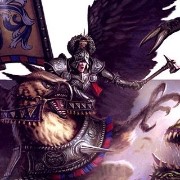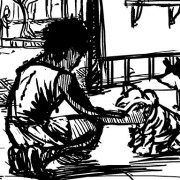|
I imagine in the 30 Years War you just followed the man in the big hat, who reports to the man in the bigger hat, and so on.
|
|
|
|

|
| # ? May 7, 2024 14:11 |
|
Endman posted:I imagine in the 30 Years War you just followed the man in the big hat, who reports to the man in the bigger hat, and so on. it's huge floppy hats all the way up but anyway, a SQUAD is five dudes, they eat and sleep together, and are probably listed together on the rolls. This has nothing to do with tactics, unless you need a few squads of dudes to take a convoy from one place to another. A COMPANY is about 300 guys on paper before the war/early in the war and about 200 guys on paper through the war. Paper numbers have nothing to do with who actually shows up. It isn't a tactical unit either. Several of these things, anywhere from 2 to...i dunno, 16? is a REGIMENT, which if it had a standard size would be about 2000 infantrymen. That is an administrative division, you fight in a BATTALION, which is a big rectangle of dudes, six deep if you're Swedish, ten deep if you're Imperialist, seven deep if you're Wallenstein at Luetzen. And if you're a Spaniard it's called an ESCUADRON and it's a perfect square. The regiment doesn't have to coincide with the battalion and especially doesn't late in the war, when everyone's regiments are smaller. If your regiment is too small to form a battalion on its own you combine them with someone else, if it's very big it divides into two batalions to fight. A whole bunch of those is an ARMY or an ARMADA. On the field it's AN ARMY EMBATTELLED. HEY GUNS fucked around with this message at 11:50 on Aug 3, 2016 |
|
|
|
Is it consistent who forms up with whom to form a battalion? What happens if one side gets their poo poo together first?
|
|
|
|
Fangz posted:Is it consistent who forms up with whom to form a battalion? What happens if one side gets their poo poo together first?
|
|
|
|
Despite my terrible track record, I'd love an another chance at getting dudes killed in a GH game.
|
|
|
|
Grey Hunter posted:Now there is a thing. I love the idea of putting HEY GAL in charge of a 30YW army.....
|
|
|
|
HEY GAL posted:COMPANY is about 300 guys on paper before the war/early in the war and about 200 guys on paper through the war. Paper numbers have nothing to do with who actually shows up. It isn't a tactical unit either. I have some vague recollections of detached companies doing fighting in the Russo-Swedish wars in the late 16th century. Of course, the armies at that point were absolutely tiny when compared to the 30 YW.
|
|
|
|
Kemper Boyd posted:I have some vague recollections of detached companies doing fighting in the Russo-Swedish wars in the late 16th century. Of course, the armies at that point were absolutely tiny when compared to the 30 YW. HEY GUNS fucked around with this message at 12:50 on Aug 3, 2016 |
|
|
|
HEY GAL posted:i don't know a drat thing about the mechanics of wargames, so if this happens other people would have to be in charge of the actual moving dudes around bit. like they did at the time, we could then make decisions by bitchy, bitchy committee. If it's anything like his other campaigns, you just order him to advance to a spot on the map he has shown you, and then marvel as everyone around you does THE ABSOLUTLY WORST WRONG THING IMAGINABLE. No worries, they think the same about you.
|
|
|
|
ArchangeI posted:marvel as everyone around you does THE ABSOLUTLY WORST WRONG THING IMAGINABLE. No worries, they think the same about you. 
|
|
|
|
HEY GAL posted:might you be remembering commanded musketeers, which is where someone takes a few musketeers from every company around, combines them into a group of about 200 or so, and uses those guys as skirmishers/to guard the baggage/to guard cannon/anywhere else they need only a few gun-having dudes to do a specific task? Nah, I remember it explicitly being distinct companies (and squadrons) from a few Swedish regiments doing *something* somewhere in Ingria or the Novgorod region. Don't have the literature for that at home, unfortunately.
|
|
|
|
One of the more remarkable things I learned from military history is human organization. For example, in the US army, the smallest unit is a "fire team" , consisting of 3-4 people with a team leader. There would be between 3-4 fire teams in a squad/section and then between 3-4 sections in a platoon and so on and so forth. There is some variation but the general idea is that any person in the military structure will have between 3-5 direct subordinates, the number of people a single person can successfully manage. Something that is just a result of centuries of warfare and a thing that has been found to just work. Has obvious application in business hierarchies.
|
|
|
|
Well, an new thread is a good excuse to start something I have been thinking about. Project Gutenberg (https://www.gutenberg.org/ebooks/25069) has the diary of a Finnish NCO from the Russian-Turkish War of 1877-78 but the whole thing is in Finnish. I was thinking of translating it day-by-day and posting here, possibly making a blog out of it in the future. The book is titled: "VÄÄPELI LEMMINKÄISEN PÄIVÄKIRJA (Diary of vääpeli(feldwebel/sergeant major) Lemminkäinen) Suomen kaartin retkestä Konstantinopolin muurien edustalle vuosina 1877-1878" (Of the trip (the term used means a liter trip, like one to a park) of the Finnish Guard to the walls of Constantinople in years 1877-78)." The book was published in Helsinki in 1899 and it doesn't mention an editor. The book contains day-by-day entries and I thought I would post one entry per post, more if they are really short (as they are). The writing style is archaic but readable, some words have changed since the days of Lemminkäinen and he uses some very convulted expressions which are pretty untranslatable, I will try to note anthing significant. The Finnish units of the Imperial Russian Army were volunteer-based and there was no conscription in the Grand Duchy of Finland (a somewhat autonomous part of the Russian Empire at the time). I'll post the entries in quotes and my own notes after the entries.
|
|
|
|
The foreword and the first entry: "FOREWORD "I would know something of it, for I was also in it" 2nd Leutenant Stool. (The above is a quote from a Finnish collection of poetry, Stories of 2nd Leutenant Stool, a book about the Swedish-Russian war of 1808-1809) Respectable readers. The following diary offers its readers certain pieces of information of the travelling places of the Finnish Guard, from the latest oriental war, its action over there and also all sorts of amusing occurrences, daily orders and adventures. The story comes from sure sources, as much as one warrior(the word used here means distinctly warrior, not soldier) has the chance to see and the ability to comprehend. I also note the respected readers, that this (book) mostly talks about the third company, for the reason that the author was in the ranks of the mentioned company for the whole war and could not follow the movements of other companies, since in war the companies of a battalion very often act in different places and, occasionally, in different ways. It is natural that there cannot be great differences there, for which reason this story somehow also details events in other companies. The story is not in any formal writing style, but rather some direct tales of a warrior, for which reason I refrain the well-known and refreshing saying:"Though strenght be lacking the will, at lest, earns thanks." This concludes the foreword. Ataxerxes fucked around with this message at 13:25 on Aug 3, 2016 |
|
|
|
BattleMoose posted:I am going to UK/France soon. Part of my trip I certainly plan on going through the Normandy beaches and maybe spending a night in Caen and so forth. Have people here been through that area before? Can you tell me if there are anything specific I should go to/do? Even if its a little out of the way and worth it, very interested. Will also be in Paris. If you have the time you should stop in Bayeux for half a day or so, it's maybe 25-30 kilometers NW of Caen. They have a pretty good WW2 museum but what you should really check out is the Bayeux Tapestry. In my opinion it's one of those "can't miss" things in Normandy if you're a history buff. I only stopped in Caen to see the fortress there, but that was neat too. In Paris you should definitely go to the French Army museum. There are six or seven different exhibits focusing on different time periods or themes, and the entire place is really fuckin' cool.
|
|
|
|
BattleMoose posted:One of the more remarkable things I learned from military history is human organization. For example, in the US army, the smallest unit is a "fire team" , consisting of 3-4 people with a team leader. There would be between 3-4 fire teams in a squad/section and then between 3-4 sections in a platoon and so on and so forth. There is some variation but the general idea is that any person in the military structure will have between 3-5 direct subordinates, the number of people a single person can successfully manage. Something that is just a result of centuries of warfare and a thing that has been found to just work. Has obvious application in business hierarchies. See also the pentonic (spelling) divisions the US tried in the cold war with 5 elements plus support units. Didn't work well.
|
|
|
|
On the subject of the Bayeux Tapestry , the Overlord Embroidery in England is pretty great
|
|
|
Ataxerxes posted:Well, an new thread is a good excuse to start something I have been thinking about. Project Gutenberg (https://www.gutenberg.org/ebooks/25069) has the diary of a Finnish NCO from the Russian-Turkish War of 1877-78 but the whole thing is in Finnish. I was thinking of translating it day-by-day and posting here, possibly making a blog out of it in the future. Hell yeah, huge 18th/19th century nerd I'm enjoying this already.
|
|
|
|
|
Jamwad Hilder posted:If you have the time you should stop in Bayeux for half a day or so, it's maybe 25-30 kilometers NW of Caen. They have a pretty good WW2 museum but what you should really check out is the Bayeux Tapestry. In my opinion it's one of those "can't miss" things in Normandy if you're a history buff. The tapestry was closed when I was in Bayeux, but we did happen upon The WWII museum by chance while driving back from Utah beach. It was a very good museum.
|
|
|
|
I just went through those memes about the middle ages that were posted on the 2nd-to-last page of the old thread and lol. Though I'm not sure what's funnier, that each of those is wrong in some way or that I've seen people in the threads repeating the bad info.
|
|
|
|
xthetenth posted:See also the pentonic (spelling) divisions the US tried in the cold war with 5 elements plus support units. Didn't work well. Yeah, pentomic as part of the ROCID program IIRC. British 'battlegroups' didn't work out very well in the 70 eithers for pretty much the same reasons. I wonder what the 1980s Soviet experience with Unified Corps was. Five or so heavy Brigades with a ton of stuff attached, and I think they were meant to wholly replace their Regiment/Divisional structure.
|
|
|
|
Ataxerxes posted:... I'm looking forward to this, but man this guy likes his sentences loooong
|
|
|
|
As a thought that just struck me, is the increased amount of mechanisation, as well as the increasingly lighter weight of body armour, a factor in the increased adoption of it in military use? WW2 practically nobody has body armour, but they're also just expected to be walking wherever they're meant to be, right? I figure if your assumption is that you're going everywhere via carriers, airlifts, and that kind of stuff, then maybe making everyone heavier is less of a problem. Or am I completely wrong?
|
|
|
|
counterpoint: early modern
|
|
|
|
spectralent posted:As a thought that just struck me, is the increased amount of mechanisation, as well as the increasingly lighter weight of body armour, a factor in the increased adoption of it in military use? WW2 practically nobody has body armour, but they're also just expected to be walking wherever they're meant to be, right? I figure if your assumption is that you're going everywhere via carriers, airlifts, and that kind of stuff, then maybe making everyone heavier is less of a problem. Or am I completely wrong? I think you are pretty completely wrong, yeah. The load carried by a soldier is essentially unchanged over the years. The lack of body armour is generally because of the lack of effective armour that can stop the full-power rifle rounds used in WWII, and not be incredibly heavy. On the eastern front where SMGs proliferated, body armour was more common. Weight is still a big issue in logistics.
|
|
|
|
It'll all be awkardly dropped when we start using lasers muskets/mass driver projectile cannons in the distant future wars on top of that really big mountain.
|
|
|
|
|
Firstly thanks to everyone's recommendations regarding France/Normandy, particularly interested in checking out some of the red zone.spectralent posted:As a thought that just struck me, is the increased amount of mechanisation, as well as the increasingly lighter weight of body armour, a factor in the increased adoption of it in military use? WW2 practically nobody has body armour, but they're also just expected to be walking wherever they're meant to be, right? I figure if your assumption is that you're going everywhere via carriers, airlifts, and that kind of stuff, then maybe making everyone heavier is less of a problem. Or am I completely wrong? The bigger issue I think (This forum make me doubt everything) is that there are newer materials available today with which to make both lightweight and functional body armour. I don't think they had the materials to make functional body armour back in WWII time. They had flak jackets for air crew but, they weren't exactly expected to walk anywhere.
|
|
|
|
Splode posted:I'm looking forward to this, but man this guy likes his sentences loooong Yeah, those multi-comma monstrosities are not considered to be the proper way to write formal Finnish today.
|
|
|
|
spectralent posted:As a thought that just struck me, is the increased amount of mechanisation, as well as the increasingly lighter weight of body armour, a factor in the increased adoption of it in military use? WW2 practically nobody has body armour, but they're also just expected to be walking wherever they're meant to be, right? I figure if your assumption is that you're going everywhere via carriers, airlifts, and that kind of stuff, then maybe making everyone heavier is less of a problem. Or am I completely wrong? As others have said, the total weight carried per soldier has generally been the same since ever as humans haven't changed much. Lighter body armor is kinda why it has been put into practice as it has to have a certain level of protection given for a certain amount of weight. Like in WW2 you possibly could have given dudes rifle-protective breastplates, but they would have weighed far too much and often not made much of a difference anyway due to getting shot in the extremities or the face. (See: Kelly Gang from 19th century Australia However the existence of the APC/IFV being a core part of the squad structure has led to soldiers being a bit more overloaded than they have been in the past as the vehicle is supposed to take them the big distances. I recall reading about some complaints in Iraq that US soldiers had no chance of chasing down insurgents as they have what, 30kg of gear on them? While Johnny Insurgent has his civvies, an AK and two magazines that he is carrying. However the bigger thing I'd say that has lead to more body armor being made is that the armies have been getting smaller.  Body armor for half a million is doable. Body armor for 3million, not so much. Just look at the soviets who were still just rocking a helmet and shirt for several decades after WW2. Mind you this isn't my area so I could be wrong but since the new thread doctrine is  ... ...
Xerxes17 fucked around with this message at 15:18 on Aug 3, 2016 |
|
|
|
yo, kemper boyd Risk Factors For Gout
And that's why all the generals we read about had gout HEY GUNS fucked around with this message at 15:30 on Aug 3, 2016 |
|
|
|
spectralent posted:As a thought that just struck me, is the increased amount of mechanisation, as well as the increasingly lighter weight of body armour, a factor in the increased adoption of it in military use? WW2 practically nobody has body armour, but they're also just expected to be walking wherever they're meant to be, right? I figure if your assumption is that you're going everywhere via carriers, airlifts, and that kind of stuff, then maybe making everyone heavier is less of a problem. Or am I completely wrong? The Soviets tried for the whole war to develop a breastplate that would protect from pistol bullets, but it turned out that in order to be thick enough to guarantee protection, the plate would be too heavy to run around in. Plus then they tested the SKS against the prototypes and shelved the whole thing. Towards the end of the war you start seeing projects for kevlar vests, but I haven't seen how those developed.
|
|
|
|
xthetenth posted:I think my favorite part of the South American dreadnought race is the Rivadavia class' ordering shenanigans. Don't forget that the cost was super low due to the US steel trusts!
|
|
|
|
Ataxerxes posted:The foreword and the first entry: post this poo poo as much as possible
|
|
|
|
Alchenar posted:My recollection (and wikipedia's assertion) is that this actually became a big thing when the Soviets reverse-engineered the B29 into the Tu4, because the B29's materials were all measured in Imperial units and the Soviets used metric - they struggled to get a conversion that a factory could use. The Smithsonian aviation magazine did an article on the creation of the Tu-4; by itself, successfully reverse engineering the world's most complex warplane was quite a engineering feat. Stalin initially wanted a totally accurate reproduction, but Tupelov gently pointed out that with all Soviet factories using metric, the Tu-4 was going to have to be built in metric as well - unless Stalin wanted to invest in completely bespoke imperial machine tools. The Soviets had wanted a B-29 really, really badly before one landed at Vladivostok. At one point during Lend-lease, they gave the Americans their latest request for aircraft. Buried in the long list of P-39s and A-26s was a request for one (1) Boeing B-29 Superfortress.
|
|
|
|
They've already gone through that song and dance for the T-26, glad to know that no one learned anything. There was also an amusing document I read that absolutely forbids Kotin from making any changes to a tractor clone that aren't absolutely necessary for production, since you just know that guy would tinker with it for a year and end up with something completely different.
|
|
|
|
Ataxerxes posted:Yeah, those multi-comma monstrosities are not considered to be the proper way to write formal Finnish today. He does say it's not in any formal writing style! By which I mean post more. Plus, commas are addictive and the habit is annoyingly hard to break
|
|
|
|
Nebakenezzer posted:The Smithsonian aviation magazine did an article on the creation of the Tu-4; by itself, successfully reverse engineering the world's most complex warplane was quite a engineering feat. Stalin initially wanted a totally accurate reproduction, but Tupelov gently pointed out that with all Soviet factories using metric, the Tu-4 was going to have to be built in metric as well - unless Stalin wanted to invest in completely bespoke imperial machine tools. That makes me wonder: Can anyone talk about how Lend-Lease was actually handled at an organizational level? Did the US government decide what to send based on what they decided they didn't need but could be useful for others? Could other states just send in a wish list like it was Christmas and Uncle Sam might bring a nice country its very own Sherman 76mm? Was there a shopping catalogue? Was there a system of value, so that you could get B-25s OR Shermans, OR a few B-25s and a handful of M3 Stuarts? Who decided what went where?
|
|
|
|
Ataxerxes posted:VÄÄPELI LEMMINKÄISEN PÄIVÄKIRJA
|
|
|
|
I think the thread should also have a rule against WWII European bombing campaign, maybe something against air combat in Pacific, too.
|
|
|
|

|
| # ? May 7, 2024 14:11 |
|
JcDent posted:I think the thread should also have a rule against WWII European bombing campaign, maybe something against air combat in Pacific, too. We don't do pacific air combat enough, other than occasionally rehashing midway and the general state of things before the hellcat.
|
|
|































